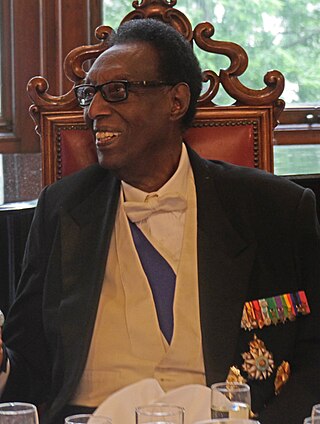Related Research Articles

Year 740 (DCCXL) was a leap year starting on Friday of the Julian calendar, the 740th year of the Common Era (CE) and Anno Domini (AD) designations, the 740th year of the 1st millennium, the 40th year of the 8th century, and the 1st year of the 740s decade. The denomination 740 for this year has been used since the early medieval period, when the Anno Domini calendar era became the prevalent method in Europe for naming years.

The Kingdom of the Franks, also known as the Frankish Kingdom, the Frankish Empire or Francia, was the largest post-Roman barbarian kingdom in Western Europe. It was ruled by the Frankish Merovingian and Carolingian dynasties during the Early Middle Ages. Francia was among the last surviving Germanic kingdoms from the Migration Period era.

South Kivu is one of 26 provinces of the Democratic Republic of the Congo (DRC). Its capital is Bukavu.

The New Kingdom, also referred to as the Egyptian Empire, was the ancient Egyptian state between the 16th century BC and the 11th century BC. This period of ancient Egyptian history covers the Eighteenth, Nineteenth, and Twentieth Dynasties. Through radiocarbon dating, the establishment of the New Kingdom has been placed between 1570 BC and 1544 BC. The New Kingdom followed the Second Intermediate Period and was succeeded by the Third Intermediate Period. It was the most prosperous time for the Egyptian people and marked the peak of Egypt's power.

The Kingdom of Navarre, originally the Kingdom of Pamplona occupied lands on both sides of the western Pyrenees, with its northernmost areas originally reaching the Atlantic Ocean, between present-day Spain and France.

Kigeli V Ndahindurwa was the last ruling King (Mwami) of Rwanda, from 28 July 1959 until the end of the UN-mandate with Belgian administration and the declaration of an independent Republic of Rwanda 1 July 1962. On 25 September 1961, a referendum voted for the abolition of the Rwandan monarchy following the Rwandan Revolution.
Mutara II Rwogera was the King of Rwanda from 1845 to his death in 1867. Under his rule and that of his successor Kigeli IV Rwabugiri, the kingdom reached its pinnacle of power.

The Kingdom of Rwanda was a Bantu kingdom in modern-day Rwanda, which grew to be ruled by a Tutsi monarchy. It was one of the oldest and the most centralized kingdoms in Central and East Africa. It was later annexed under German and Belgian colonial rule while retaining some of its autonomy. The Tutsi monarchy was abolished in 1961 after ethnic violence erupted between the Hutu and the Tutsi during the Rwandan Revolution which started in 1959. After a 1961 referendum, Rwanda became a Hutu-dominated republic and received its independence from Belgium in 1962.

Yuhi Musinga was a king (umwami) of Rwanda who came to power in 1896 and collaborated with the German government to strengthen his own kingship. In 1931 he was deposed by the Belgian administration because of his inability to work with subordinate chiefs and his refusal to be baptized a Roman Catholic. His eldest son, Mutara III Rudahigwa, succeeded him.

Kigeli IV Rwabugiri was the king (mwami) of the Kingdom of Rwanda in the mid-nineteenth century. He was among the last Nyiginya kings in a ruling dynasty that had traced its lineage back four centuries to Gihanga, the first 'historical' king of Rwanda whose exploits are celebrated in oral chronicles. He was a Tutsi with the birth name Sezisoni Rwabugiri. He was the first king in Rwanda's history to come into contact with Europeans. He established an army equipped with guns he obtained from Germans and prohibited most foreigners, especially Arabs, from entering his kingdom.
The Hororo or Bahororo are a Bantu-speaking ethnicity mainly residing in the north of the former Kigezi District in southwestern Uganda. In 1905, they were described by a British officer as a "quiet, inoffensive people" who owned cattle. They are made up mostly of the Hima ethnic group and the Iru ethnic group. They reside mainly in Rujumbura in southwestern Uganda and are related to the Banyankole, Banyoro, Batooro, Songora and Tutsi peoples respectively. Rujumbura was ruled by the BeeneKirenzi sub-clan with Omukama Karegyesa as their last king. The Bahororo speak a dialect of Nkore-Kiga, Ruhororo. They are subdivided into clans that are similar to those of the kingdom of Ankole. Unlike Ankole, which was ruled by the Hinda clan, Mpororo was led by the Bashambo clan.
The Banyarwanda are a Bantu ethnolinguistic supraethnicity. The Banyarwanda are also minorities in neighboring DR Congo, Uganda and Tanzania.

The Qedarites were an ancient Arab tribal confederation centred in their capital Dumat al-Jandal in the present-day Saudi Arabian province of Al-Jawf. Attested from the 9th century BC, the Qedarites formed a powerful polity which expanded its territory throughout the 9th to 7th centuries BC to cover a large area in northern Arabia stretching from Transjordan in the west to the western borders of Babylonia in the east, before later consolidating into a kingdom that stretched from the eastern limits of the Nile Delta in the west till Transjordan in the east and covered much of southern Judea, the Negev and the Sinai Peninsula.

The Rwandan Revolution, also known as the Hutu Revolution, Social Revolution, or Wind of Destruction, was a period of ethnic violence in Rwanda from 1959 to 1961 between the Hutu and the Tutsi, two of the three ethnic groups in Rwanda. The revolution saw the country transition from a Tutsi monarchy under Belgian colonial authority to an independent Hutu-dominated republic.
The Songora or Shongora are a traditionally pastoralist people of the Great Lakes region of Central Africa located in Western Region, Uganda and Eastern Democratic Republic of the Congo. They have distinctive customs and speak Rusongora, a Bantu language that is similar to Runyankole and Runyoro. The Basongora population in Uganda was reported at numbering 15,897 people in the 2014 census. Although various community estimates put their population at around 40,000 and 50,000 people. Some Basongora also live in Eastern Congo.
Kigeli I Mukobanya was, according to tradition, Mwami of the Kingdom of Rwanda dated to 1378 C.E to 1418 C.E.
Cyilima II Rujugira was Mwami (King) of Kingdom of Rwanda from 1770 to 1786. Cyilima II Rujugira is famous for coining the phrase "Urwanda ruratera ntiruterwa".
Kigeli III Ndabarasa was a warrior Mwami of the Kingdom of Rwanda during the eighteenth century. The son of Cyilima II Rujugira, he was raised to be co-ruler by his father before attaining the throne on his death in 1765 or 1786. His reign was marked by military campaigns that expanded Rwandan territory and control. He brought the people of Ndorwa into the kingdom and conquered the small kingdom of Muabli. He expanded the large number of armies he had inherited from his father and founded new armies in Ndorwa and Burundi. He increased support for his military force by creating four new herds of cattle for his army, as well as ten for cattle-herders, and expanded the number of domains for cattle herding into new territories. At the same time, the observance of the practice of veneration for ancestors decreased during his reign. He died due to complications from an operation and was succeeded by his son Sentabyo.

The Kingdom of Bugesera was an independent Bantu kingdom that existed from the 16th to 18th century in Central Africa. Around 1799, it was conquered and divided by the Kingdom of Rwanda and Kingdom of Burundi.
References
- ↑ Kagame, Alexis (1972). Un Abrégé de l'Histoire du Rwanda. Butare: Editions Universitaires du Rwanda.
